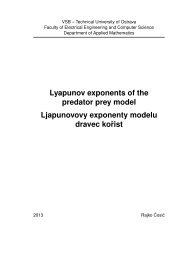The Boundary Element Method for the Helmholtz Equation ... - FEI VÅ B
The Boundary Element Method for the Helmholtz Equation ... - FEI VÅ B
The Boundary Element Method for the Helmholtz Equation ... - FEI VÅ B
You also want an ePaper? Increase the reach of your titles
YUMPU automatically turns print PDFs into web optimized ePapers that Google loves.
313.1 Single Layer Potential OperatorLet us first consider <strong>the</strong> operator V κ defined by (3.3). Recall, that <strong>for</strong> <strong>the</strong> Dirichlet traceoperator γ 0 we haveγ 0 : H 1 loc (Ω) → H1/2 (∂Ω).Combining this operator with V κ we obtain <strong>the</strong> single layer potential operatorV κ : H −1/2 (∂Ω) → H 1/2 (∂Ω), V κ := γ 0 Vκ .From linearity and continuity of γ 0 and V κ we get that <strong>the</strong> single layer potential operatoris linear and continuous, i.e., <strong>the</strong>re exists a constant c ∈ R + such that∥V κ s∥ H 1/2 (∂Ω) ≤ c∥s∥ H −1/2 (∂Ω)<strong>for</strong> all s ∈ H −1/2 (∂Ω).<strong>The</strong>orem 3.8. <strong>The</strong> single layer potential operator V κ : H −1/2 (∂Ω) → H 1/2 (∂Ω) is coercive.Proof. From <strong>The</strong>orem 6.22 in [18] we have that he operator V 0 corresponding to <strong>the</strong> Laplaceequation, i.e., <strong>the</strong> <strong>Helmholtz</strong> equation with κ = 0, is H −1/2 (∂Ω)-elliptic. Moreover, <strong>the</strong>operator C := V 0 − V κ : H −1/2 (∂Ω) → H 1/2 (∂Ω) is compact (see [18], Section 6.9). Thus,we have⟨(V κ + C)s, s⟩ = ⟨V 0 s, s⟩ ≥ c∥s∥ 2 H −1/2 (∂Ω)<strong>for</strong> all s ∈ H −1/2 (∂Ω),which completes <strong>the</strong> proof.<strong>The</strong>orem 3.9. For s ∈ L ∞ (∂Ω) <strong>the</strong>re holds <strong>the</strong> representation(V κ s)(x) = v κ (x, y)s(y) ds y <strong>for</strong> x ∈ ∂Ω.Proof. <strong>The</strong> proof is similar to <strong>the</strong> proof of Lemma 6.7 in [18].∂ΩMoreover, <strong>for</strong> <strong>the</strong> jump of <strong>the</strong> Dirichlet trace of <strong>the</strong> single layer potential V κ s on <strong>the</strong>boundary we have[γ 0 Vκ s] := γ 0,ext Vκ s − γ 0,int Vκ s = 0 <strong>for</strong> all s ∈ H −1/2 (∂Ω). (3.5)3.2 Adjoint Double Layer Potential OperatorIn Section 1.4 we introduced <strong>the</strong> Neumann trace operatorγ 1 : H 1 loc (Ω, ∆ + κ2 ) → H −1/2 (∂Ω).









